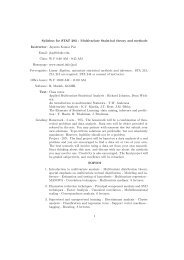Zonal Polynomials and Hypergeometric Functions of Matrix Argument
Zonal Polynomials and Hypergeometric Functions of Matrix Argument
Zonal Polynomials and Hypergeometric Functions of Matrix Argument
Create successful ePaper yourself
Turn your PDF publications into a flip-book with our unique Google optimized e-Paper software.
<strong>Zonal</strong> <strong>Polynomials</strong> <strong>and</strong> <strong>Hypergeometric</strong> <strong>Functions</strong> <strong>of</strong><br />
<strong>Matrix</strong> <strong>Argument</strong><br />
<strong>Zonal</strong> <strong>Polynomials</strong> <strong>and</strong> <strong>Hypergeometric</strong> <strong>Functions</strong> <strong>of</strong> <strong>Matrix</strong> <strong>Argument</strong> – p. 1/2
<strong>Zonal</strong> <strong>Polynomials</strong> <strong>and</strong> <strong>Hypergeometric</strong> <strong>Functions</strong> <strong>of</strong> <strong>Matrix</strong> <strong>Argument</strong> – p. 2/2<br />
Some matrix spaces<br />
G = GL(n, R): The general linear group, containing all n × n<br />
nonsingular real matrices<br />
S = S(n, R): The space <strong>of</strong> real symmetric matrices<br />
G “acts” on S: x ∈ G acts on s ∈ S by x ◦ s ≡ xsx ′<br />
x 1 x 2 ◦ s = (x 1 x 2 )s(x 1 x 2 ) ′ = x 1 x 2 sx ′ 2x ′ 1<br />
= x 1 (x 2 sx ′ 2)x ′ 1 = x 1 (x 2 ◦ s)x ′ 1 = x 1 ◦ (x 2 ◦ s)<br />
x 1 x 2 ◦ s = x 1 ◦ (x 2 ◦ s)<br />
This is a group action<br />
right-action vs. left-action
<strong>Zonal</strong> <strong>Polynomials</strong> <strong>and</strong> <strong>Hypergeometric</strong> <strong>Functions</strong> <strong>of</strong> <strong>Matrix</strong> <strong>Argument</strong> – p. 3/2<br />
Notation: For x = (x ij ) ∈ G,<br />
∆(x) := det(x)<br />
⎛<br />
⎞<br />
x 11 · · · x 1j<br />
⎜<br />
⎟<br />
∆ j (x) = ∆ ⎝ . . ⎠ ,<br />
x j1 · · · x jj<br />
j = 1, . . . , n<br />
The st<strong>and</strong>ard bitriangular structure <strong>of</strong> G: Each x ∈ G can be<br />
expressed as x = vcu where<br />
c is diagonal<br />
u is upper triangular with 1’s on the main diagonal<br />
v is lower triangular with 1’s on the main diagonal
<strong>Zonal</strong> <strong>Polynomials</strong> <strong>and</strong> <strong>Hypergeometric</strong> <strong>Functions</strong> <strong>of</strong> <strong>Matrix</strong> <strong>Argument</strong> – p. 4/2<br />
The map from (u, c, v) → vcu is smooth when restricted to the<br />
subset <strong>of</strong> matrices x ∈ G such that<br />
n∏<br />
∆ j (x) ≠ 0<br />
j=1<br />
O(n): the group <strong>of</strong> n × n orthogonal matrices<br />
O(n) is a maximal compact subgroup <strong>of</strong> G<br />
P (n, R): The cone <strong>of</strong> positive definite n × n matrices<br />
Each r ∈ P (n, R) is <strong>of</strong> the form r = xx ′ , x ∈ G
<strong>Zonal</strong> <strong>Polynomials</strong> <strong>and</strong> <strong>Hypergeometric</strong> <strong>Functions</strong> <strong>of</strong> <strong>Matrix</strong> <strong>Argument</strong> – p. 5/2<br />
<strong>Polynomials</strong> on G<br />
φ: A polynomial function on G<br />
φ(x) is a polynomial in the entries x ij <strong>of</strong> x<br />
P(G): The space <strong>of</strong> polynomials on G<br />
P d (G): The space <strong>of</strong> polynomials homogeneous <strong>of</strong> degree d<br />
P d (G) is a vector space <strong>of</strong> dimension ( )<br />
N+d−1<br />
N−1 , where N ≡ n<br />
2<br />
G is an open subset <strong>of</strong> R n×n<br />
φ extends uniquely to a polynomial on R n×n<br />
A polynomial on G restricts uniquely to a polynomial on P (n, R)
<strong>Zonal</strong> <strong>Polynomials</strong> <strong>and</strong> <strong>Hypergeometric</strong> <strong>Functions</strong> <strong>of</strong> <strong>Matrix</strong> <strong>Argument</strong> – p. 6/2<br />
For a ∈ G, define R a : P(G) → P(G) by:<br />
R a φ(x) = φ(xa),<br />
x ∈ G<br />
R a is called the right regular representation <strong>of</strong> G on P(G)<br />
What is R a if a = I n <br />
R ab φ = R b R a φ<br />
P d (G) is invariant under R a : R a P d (G) = P d (G)
Regard R n×n as R N<br />
Each polynomial φ on R n×n is a polynomial on R N<br />
φ(x) =<br />
∑<br />
a α1 ,...,α N<br />
x α 1<br />
1 xα 2<br />
2 · · · xα N<br />
N<br />
α 1 ,...,α N<br />
Shorth<strong>and</strong> notation:<br />
φ(x) = ∑ a α X α<br />
α<br />
α! = α 1 ! · · · α N !<br />
Conjugate <strong>of</strong> φ:<br />
˜φ(x) =<br />
∑<br />
α āαX α <strong>Zonal</strong> <strong>Polynomials</strong> <strong>and</strong> <strong>Hypergeometric</strong> <strong>Functions</strong> <strong>of</strong> <strong>Matrix</strong> <strong>Argument</strong> – p. 7/2
<strong>Zonal</strong> <strong>Polynomials</strong> <strong>and</strong> <strong>Hypergeometric</strong> <strong>Functions</strong> <strong>of</strong> <strong>Matrix</strong> <strong>Argument</strong> – p. 8/2<br />
The differentiation inner product on P(G)<br />
For φ = ∑ α a αX α <strong>and</strong> ψ = ∑ α b αX α , define the inner product<br />
〈φ|ψ〉 = ∑ α<br />
α!a α¯bα<br />
This inner product arises from differentiation <strong>of</strong> ψ by φ<br />
HW: Prove that for k ∈ O(n), R k is a unitary operator on P(G):<br />
〈R k φ|R k ψ〉 = 〈φ|ψ〉<br />
Hint: Show that 〈R a ′φ|R a −1ψ〉 = 〈φ|ψ〉, a ∈ G<br />
Under the inner product,<br />
∞∑<br />
P(G) = ⊕P d (G)<br />
d=0
<strong>Zonal</strong> <strong>Polynomials</strong> <strong>and</strong> <strong>Hypergeometric</strong> <strong>Functions</strong> <strong>of</strong> <strong>Matrix</strong> <strong>Argument</strong> – p. 9/2<br />
Representations <strong>of</strong> G<br />
G: GL(n, R)<br />
V : A space <strong>of</strong> linear transformations<br />
ρ : G → V is a representation <strong>of</strong> G on V if<br />
ρ(xy) = ρ(x)ρ(y), x, y ∈ G<br />
The dimension <strong>of</strong> ρ is the dimension <strong>of</strong> V<br />
Example: The right regular representation<br />
Example: ρ(x) = ∆(x) k ∆(x) l is a one-dimensional<br />
representation <strong>of</strong> G<br />
All one-dimensional representations <strong>of</strong> G are powers <strong>of</strong> ∆(x)
<strong>Zonal</strong> <strong>Polynomials</strong> <strong>and</strong> <strong>Hypergeometric</strong> <strong>Functions</strong> <strong>of</strong> <strong>Matrix</strong> <strong>Argument</strong> – p. 10/2<br />
Given representations ρ 1 , ρ 2 , form the direct sum<br />
(<br />
)<br />
ρ 1 (x) 0<br />
(ρ 1 ⊕ ρ 2 (x) =<br />
0 ρ 2 (x)<br />
This gives us a new representation<br />
Irreducible representations: Those which cannot be written as a<br />
direct sum <strong>of</strong> lower-dimensional representations<br />
The basic problem in representation theory: Describe all<br />
irreducible representations <strong>of</strong> a group<br />
G = GL(n, R): We use the st<strong>and</strong>ard bitriangular decomposition<br />
to describe some irreducible polynomial representations <strong>of</strong> G
<strong>Zonal</strong> <strong>Polynomials</strong> <strong>and</strong> <strong>Hypergeometric</strong> <strong>Functions</strong> <strong>of</strong> <strong>Matrix</strong> <strong>Argument</strong> – p. 11/2<br />
Each irreducible, finite-dimensional, polynomial representation<br />
<strong>of</strong> GL(n, R) is parametrized by an n-tuple (m 1 , . . . , m n ) <strong>of</strong><br />
integers where m 1 ≥ · · · ≥ m n ≥ 0<br />
π m : The representation corresponding to the signature<br />
m = (m 1 , . . . , m n )<br />
Return to the (U, C, V ) decomposition: x = vcu<br />
For each signature m <strong>and</strong> c = diag(c 1 , . . . , c n ), let<br />
µ m (c) = |c 1 | 2m 1<br />
|c 2 | 2m2 · · · |c n | 2m n<br />
µ m is a character <strong>of</strong> C<br />
µ m is a one-dimensional representation <strong>of</strong> C
<strong>Zonal</strong> <strong>Polynomials</strong> <strong>and</strong> <strong>Hypergeometric</strong> <strong>Functions</strong> <strong>of</strong> <strong>Matrix</strong> <strong>Argument</strong> – p. 12/2<br />
P 2m (G): The collection <strong>of</strong> all φ ∈ P(G) such that<br />
φ(vcx) = µ 2m (c)φ(x), v ∈ V, c ∈ C, x ∈ R n×n<br />
Each φ in P 2m (G) is homogeneous:<br />
P 2m (G) ⊂ P d (G),<br />
d = 2|m|, |m| = m 1 + · · · + m n<br />
A crucial example <strong>of</strong> a polynomial in P 2m (G):<br />
φ 2m (x) = ∆(x) 2m n<br />
n−1<br />
∏<br />
∆ j (x) 2(m j−m j+1 )<br />
j=1<br />
Calculate ∆ j (vcx) to see why φ 2m ∈ P 2m (G)<br />
More comments on the representation theory <strong>of</strong> G
<strong>Zonal</strong> <strong>Polynomials</strong> <strong>and</strong> <strong>Hypergeometric</strong> <strong>Functions</strong> <strong>of</strong> <strong>Matrix</strong> <strong>Argument</strong> – p. 13/2<br />
Orthogonally invariant polynomials<br />
I(G): The space <strong>of</strong> left-invariant polynomials φ on G,<br />
φ(kx) = φ(x), k ∈ O(n), x ∈ G<br />
If φ is homogeneous then it is <strong>of</strong> even degree, because<br />
−I n ∈ O(n)<br />
I 2d (G): The class <strong>of</strong> φ ∈ I(G) which are homogeneous <strong>of</strong><br />
degree 2d<br />
I(G) =<br />
∞∑<br />
⊕I 2d (G)<br />
d=0<br />
The spherical transform: Given φ ∈ P(G), construct φ # ∈ I(G):<br />
∫<br />
φ # (x) = φ(kx) dk<br />
O(n)
<strong>Zonal</strong> <strong>Polynomials</strong> <strong>and</strong> <strong>Hypergeometric</strong> <strong>Functions</strong> <strong>of</strong> <strong>Matrix</strong> <strong>Argument</strong> – p. 14/2<br />
Apply the spherical transform to each φ ∈ P 2m (G) to get the<br />
space I 2m (G)<br />
The spherical transform decomposes I 2d (G) into irreducible,<br />
orthogonal subspaces<br />
I 2d (G) = ∑<br />
⊕I 2m (G)<br />
|m|=d<br />
S = S(n, R): The space <strong>of</strong> real symmetric matrices<br />
Each polynomial φ on G gives rise to a polynomial q on S:<br />
q(xx ′ ) = φ(x)<br />
The spherical transform converts each left-invariant polynomial p<br />
on G into a biinvariant polynomial q on S
<strong>Zonal</strong> <strong>Polynomials</strong> <strong>and</strong> <strong>Hypergeometric</strong> <strong>Functions</strong> <strong>of</strong> <strong>Matrix</strong> <strong>Argument</strong> – p. 15/2<br />
The zonal polynomials<br />
Apply the spherical transform to I 2d (G) <strong>and</strong> I 2m (G)<br />
P d (S) = ∑<br />
|m|=d<br />
⊕P m (S)<br />
This decomposition is multiplicity free: Up to constant multiples,<br />
there exists only one nontrivial, biinvariant polynomial in P m (S)<br />
This unique polynomial is called the zonal polynomial<br />
Let φ ∈ P d (S), φ(ksk ′ ) = φ(s), k ∈ O(n), s ∈ S. Then there exist<br />
unique φ m ∈ P m (S) such that<br />
φ = ∑<br />
|m|=d<br />
φ m<br />
The {φ m } are orthogonal w.r.t. the differentiation inner product
<strong>Zonal</strong> <strong>Polynomials</strong> <strong>and</strong> <strong>Hypergeometric</strong> <strong>Functions</strong> <strong>of</strong> <strong>Matrix</strong> <strong>Argument</strong> – p. 16/2<br />
Is each subspace P m (S) nontrivial Is there an explicit formula<br />
for each zonal polynomial<br />
Apply the spherical transform to the “crucial example” in P 2m (G)<br />
q m (s) =<br />
∫<br />
O(n)<br />
∆(ksk ′ ) m n<br />
n−1<br />
∏<br />
j=1<br />
∆ j (ksk ′ ) m j−m j+1<br />
dk<br />
q m ∈ P m (S) <strong>and</strong> q m > 0 on the cone <strong>of</strong> positive definite matrices<br />
Conclude: Each P m (S) is nontrivial<br />
q m is the zonal polynomial <strong>of</strong> weight m
<strong>Zonal</strong> <strong>Polynomials</strong> <strong>and</strong> <strong>Hypergeometric</strong> <strong>Functions</strong> <strong>of</strong> <strong>Matrix</strong> <strong>Argument</strong> – p. 17/2<br />
In multivariate statistical analysis, we choose the zonal<br />
polynomials Z m to be such that<br />
(tr s) d = ∑<br />
Z m (s)<br />
|m|=d<br />
∫<br />
Z m (s) = Z m (I n )<br />
O(n)<br />
∆(ksk ′ ) m n<br />
n−1<br />
∏<br />
j=1<br />
∆ j (ksk ′ ) m j−m j+1<br />
dk<br />
This requires that we be able to calculate Z m (I n )<br />
James (1964), Muirhead (1982), Gross <strong>and</strong> D.R. (1987), etc.
<strong>Zonal</strong> <strong>Polynomials</strong> <strong>and</strong> <strong>Hypergeometric</strong> <strong>Functions</strong> <strong>of</strong> <strong>Matrix</strong> <strong>Argument</strong> – p. 18/2<br />
Theorem: Z m is an eigenfunction <strong>of</strong> the Laplace-Beltrami<br />
operator <strong>and</strong>, more generally, all G-invariant differential<br />
operators on S<br />
D s : A G-invariant differential operator<br />
D s = D x′ sx, s ∈ S, x ∈ G<br />
If s = (s ij ) ∈ S, set<br />
(<br />
∂ s = 1<br />
2 (1 + δ ij) ∂ )<br />
∂s ij<br />
Examples <strong>of</strong> invariant differential operators<br />
tr (s∂ s ) k , k = 1, 2, . . . ; ∆(s∂ s )
<strong>Zonal</strong> <strong>Polynomials</strong> <strong>and</strong> <strong>Hypergeometric</strong> <strong>Functions</strong> <strong>of</strong> <strong>Matrix</strong> <strong>Argument</strong> – p. 19/2<br />
tr (s∂ s ) 2 is the Laplace-Beltrami operator<br />
It can be shown that<br />
q m (s) = ∆(s) m n<br />
n−1<br />
∏<br />
j=1<br />
∆ j (s) m j−m j+1<br />
is an eigenfunction <strong>of</strong> every invariant differential operator D s<br />
Since D s is G-invariant then D s = D ksk<br />
′<br />
D.R. (SIAM J. Math. Analysis, 1985): Applications <strong>of</strong> invariant<br />
differential operators ...
<strong>Zonal</strong> <strong>Polynomials</strong> <strong>and</strong> <strong>Hypergeometric</strong> <strong>Functions</strong> <strong>of</strong> <strong>Matrix</strong> <strong>Argument</strong> – p. 20/2<br />
D s Z m (s) ∝ D s<br />
∫<br />
=<br />
=<br />
∝<br />
∫<br />
∫<br />
∫<br />
O(n)<br />
O(n)<br />
O(n)<br />
= Z m (s)<br />
O(n)<br />
q m (ksk ′ ) dk<br />
D s q m (ksk ′ ) dk<br />
D ksk ′q m (ksk ′ ) dk<br />
q m (ksk ′ ) dk
<strong>Zonal</strong> <strong>Polynomials</strong> <strong>and</strong> <strong>Hypergeometric</strong> <strong>Functions</strong> <strong>of</strong> <strong>Matrix</strong> <strong>Argument</strong> – p. 21/2<br />
Theorem: For s, t ∈ S,<br />
∫<br />
Z m (ksk ′ t) dk = Z m(s) Z m (t)<br />
Z m (I n )<br />
O(n)<br />
Denote the LHS by f(s)<br />
Check that f is an eigenfunction <strong>of</strong> every invariant D s<br />
Therefore f(s) ∝ Z m (s)<br />
Evaluate f at the identity matrix<br />
We can also evaluate Laplace transforms <strong>of</strong> Z m <strong>and</strong> q m
<strong>Zonal</strong> <strong>Polynomials</strong> <strong>and</strong> <strong>Hypergeometric</strong> <strong>Functions</strong> <strong>of</strong> <strong>Matrix</strong> <strong>Argument</strong> – p. 22/2<br />
The invariant measure on P (n, R): d ∗ s = ∆(s) −(p+1)/2 ds<br />
For Re(α) > (n − 1)/2,<br />
∫<br />
e −tr r ∆(r) α q m (r)d ∗ r = [α] m Γ n (α)<br />
P<br />
where (α) k = α(α + 1) · · · (α + k − 1) = Γ(α + k)/Γ(α)<br />
n∏ (<br />
[α] m = α −<br />
1<br />
2 (j − 1)) m j<br />
j=1<br />
Γ n (α) = π n(n−1)/4<br />
n ∏<br />
j=1<br />
Γ ( α − 1 2<br />
(j − 1))<br />
Pro<strong>of</strong>: Apply the st<strong>and</strong>ard bitriangular structure (a.k.a. Bartlett<br />
decomposition), etc.
<strong>Zonal</strong> <strong>Polynomials</strong> <strong>and</strong> <strong>Hypergeometric</strong> <strong>Functions</strong> <strong>of</strong> <strong>Matrix</strong> <strong>Argument</strong> – p. 23/2<br />
For z ∈ P (n, R), s ∈ S,<br />
∫<br />
e −tr rz ∆(r) α Z m (rs)d ∗ r = [α] m Γ n (α)∆(z) −α Z m (sz −1 )<br />
P<br />
Denote this integral by F (s, z)<br />
We already know F (I n , I n )<br />
Check that F (s, I n ) is O(n) invariant <strong>and</strong> is in P m (S)<br />
Therefore F (s, I n ) ∝ Z m (s)<br />
Use a change <strong>of</strong> variables to show that<br />
F (s, z) = ∆(z) −α F (z −1/2 sz −1/2 , I n )
<strong>Zonal</strong> <strong>Polynomials</strong> <strong>and</strong> <strong>Hypergeometric</strong> <strong>Functions</strong> <strong>of</strong> <strong>Matrix</strong> <strong>Argument</strong> – p. 24/2<br />
For z ∈ S,<br />
∫<br />
0
<strong>Zonal</strong> <strong>Polynomials</strong> <strong>and</strong> <strong>Hypergeometric</strong> <strong>Functions</strong> <strong>of</strong> <strong>Matrix</strong> <strong>Argument</strong> – p. 25/2<br />
<strong>Hypergeometric</strong> functions <strong>of</strong> matrix argument<br />
Recall:<br />
[α] m =<br />
n∏<br />
j=1<br />
(<br />
α −<br />
1<br />
2 (j − 1)) m j<br />
The generalized hypergeometric function with argument s ∈ S:<br />
pF q (α 1 , . . . , α p ; β 1 , . . . , β q ; s) =<br />
When do these series converge<br />
∞∑ ∑<br />
d=0 |m|=d<br />
[α 1 ] m · · · [α p ] m Z m (s)<br />
[β 1 ] m · · · [β q ] m d!<br />
Reinhardt domain <strong>of</strong> convergence: Gross <strong>and</strong> D.R. (1987),<br />
Faraut <strong>and</strong> Korányi (1994)
<strong>Zonal</strong> <strong>Polynomials</strong> <strong>and</strong> <strong>Hypergeometric</strong> <strong>Functions</strong> <strong>of</strong> <strong>Matrix</strong> <strong>Argument</strong> – p. 26/2<br />
Example 1: The series for 0 F 0 converges everywhere on S<br />
0F 0 (s) =<br />
∞∑<br />
= ∑ d=0<br />
∑<br />
d=0 |m|=d<br />
1<br />
d!<br />
∑<br />
|m|=d<br />
= ∑ 1<br />
(tr s)d<br />
d!<br />
d=0<br />
= exp(tr s)<br />
Z m (s)<br />
d!<br />
Z m (s)
<strong>Zonal</strong> <strong>Polynomials</strong> <strong>and</strong> <strong>Hypergeometric</strong> <strong>Functions</strong> <strong>of</strong> <strong>Matrix</strong> <strong>Argument</strong> – p. 27/2<br />
Example 2: The series for 1 F 0 converges for ||s|| < 1<br />
∆(I n − s) −α = 1<br />
Γ n (α)<br />
= 1<br />
Γ n (α)<br />
= 1<br />
Γ n (α)<br />
= ∑ d=0<br />
1<br />
d!<br />
∫<br />
∫<br />
P<br />
P<br />
∑<br />
d=0<br />
= 1 F 0 (α; s)<br />
∑<br />
e −tr (I n−s)r ∆(r) α d ∗ r<br />
e −tr r 0F 0 (rs)∆(r) α d ∗ r<br />
1<br />
d!<br />
|m|=d<br />
∑<br />
|m|=d<br />
∫<br />
P<br />
[α] m Z m (s)<br />
d!<br />
e −tr r ∆(r) α Z m (rs) d ∗ r
<strong>Zonal</strong> <strong>Polynomials</strong> <strong>and</strong> <strong>Hypergeometric</strong> <strong>Functions</strong> <strong>of</strong> <strong>Matrix</strong> <strong>Argument</strong> – p. 28/2<br />
Laplace <strong>and</strong> beta integrals<br />
For p ≤ q <strong>and</strong> Re(α p+1 ) > (n − 1)/2,<br />
1<br />
Γ n (α p+1 )<br />
∫<br />
P<br />
e −tr rz pF q (α 1 , . . . , α p ; β 1 , . . . , β q ; r)∆(r) α p+1<br />
d ∗ r<br />
= ∆(z) −α p+1<br />
p+1 F q (α 1 , . . . , α p , a p+1 ; β 1 , . . . , β q ; z −1 )<br />
Note: If p = q then the RHS converges for ||z −1 || < 1<br />
∫<br />
0
<strong>Zonal</strong> <strong>Polynomials</strong> <strong>and</strong> <strong>Hypergeometric</strong> <strong>Functions</strong> <strong>of</strong> <strong>Matrix</strong> <strong>Argument</strong> – p. 29/2<br />
A few references<br />
Herz (1955)<br />
Constantine (1962)<br />
James (1964)<br />
Maass (1971)<br />
Muirhead (1982)<br />
Gross <strong>and</strong> D.R. (1987)<br />
D.R. (Editor). Contemp. Math., Vol. 138, 1992<br />
Faraut <strong>and</strong> Korányi (1994)






